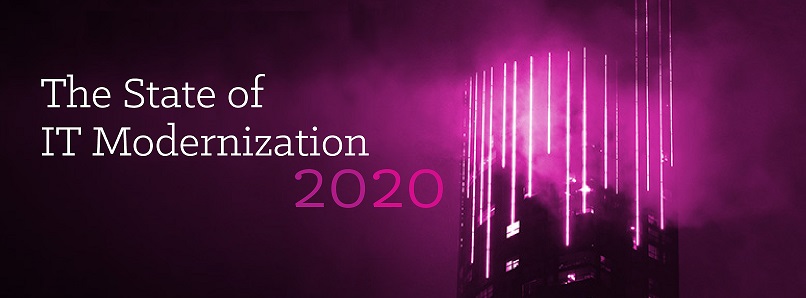In recent years, with the emergence of newer technologies ranging from the cloud to machine learning, IT modernization has evolved from a replacement of end-of-life infrastructure to an enabler of innovation and business value. It is a complex process that can take months or even years, but a recent survey shows that the effort begins to deliver measurable results almost as soon as an organization executes the first steps on its roadmap.
In The State of IT Modernization 2020, an IDG Research Services survey of 200 IT executives commissioned last December by Insight Enterprises' Cloud + Data Center Transformation team, respondents that had completed 25% or less of their initial modernization objectives reported achieving business improvements in each of the eight categories measured. 65% had already achieved better quality of service. Significant progress had also been made in improving customer experience/satisfaction (52%), cost savings (50%), uptime (44%) and the ability to create new revenue-generating products and services (42%).
Organizations that had completed their initial modernization objectives reported even better outcomes on all eight measures, notably including the ability to extract business value from data (56%) and faster time to market for new products and services (50%).
The findings clearly demonstrate that a modernized IT ecosystem is a core building block of business transformation. Whether it's spinning up a new service or application quickly, doing a deep data dive to identify new market opportunities, or using artificial intelligence to improve sales forecasts or warehouse operations, it's essential to have the horsepower, agility and advanced data analysis capabilities to do the job.
The survey of CIOs, CTOs, CSOs and IT directors working at organizations with an average of 29,294 employees also revealed a wide range of details about the status of IT modernization efforts. For example:
Progress Made
56% of the enterprises surveyed have either achieved initial IT modernization objectives or have made significant progress toward doing so, while 19% have made moderate progress and 26% are in the beginning stages. Interestingly, even those in the earliest stages are pursuing emerging technologies such as AI, machine and/or deep learning (43%), automation to support scale-out and other cloud strategies (37%), cloud native application development (35%), and public cloud container services (35%).
Projects Derailed
Despite this progress, the road to IT modernization can be bumpy. 41% of survey respondents reported having delayed or abandoned some of their 2019 IT modernization initiatives. The top reasons cited were competing priorities (46%) and lack of a clear roadmap or strategy (45%). Other causes included data security concerns (39%), inadequate in-house expertise (38%), poor preparation (29%) and outdated processes or tools (27%).
Shifting Cloud Strategy
Whether they have just embarked on their IT modernization journey or have made significant progress on their roadmap, organizations continue to grapple with optimizing their cloud strategy. The survey showed that:
■ 92% of survey respondents increased workloads deployed in the public cloud and 91% in the private cloud in 2019, reflecting the ongoing increase in cloud adoption as well as migration from one platform to another.
■ 89% switched or planned to switch from an all-private or all-public cloud strategy to a hybrid cloud approach — and 87% adopted a multicloud approach using more than one public cloud provider — as they attempted to find the right path for their cloud needs.
■ 84% moved select workloads from a public cloud to an alternative cloud or non-cloud location, suggesting a failure to perform appropriate cost modeling, workload/platform alignment and other due diligence before the initial move.
Poor Public Cloud Cost Controls
More than two-thirds of survey respondents reported that public cloud costs exceeded their expectations, with cost overruns for roughly half that group ranging from 51-100%. Most of the causes can be traced to inadequate due diligence, governance or cloud optimization efforts, often due to a lack of in-house expertise in these areas. Examples include unexpected data egress charges, subscribing to more cloud resources than required, failure to take advantage of vendor volume discounts, lack of knowledge to analyze monthly cloud costs, and failure to optimize cloud workloads to extract maximum value from cloud platforms.
Managed Services
Adoption of managed services is widespread at every stage of the IT modernization journey, with an average of 95% of respondents outsourcing one or more IT operating environment functions to a managed services provider and 84% outsourcing cloud management.
Top Challenges Faced
Governance is the #1 modernization challenge in 2020, according to survey respondents, with new strategies and processes required to ensure control over areas ranging from cloud deployments to Continuous Integration and Continuous Delivery (CICD), automation and orchestration, and infrastructure as code. Optimizing and managing the “centers of data” that are replacing the traditional data center ranks #2, with workloads located on-premises and in multiple clouds as well as on the edge.
At the same time, most IT organizations have long-standing cultural and technological norms that need to change in order to move modernization initiatives forward. Hurdles cited elsewhere in the survey range from IT silos to outdated processes and tools, understaffed or underskilled DevOps teams, and lack of enabling technology for containerization and automation. These challenges also need to be overcome in order to take full advantage of today's technology to drive innovation, business transformation, and the competitive edge that can help businesses both survive and thrive in today's economy.


